-
 Iron tsuba of slightly elongated round form decorated with three pairs of snowflake-form small perforations (ko-sukashi), each outlined with brass wire; five concentric circular rows of dots inlaid in brass or copper ten-zōgan (some dots are missing). Hitsu-ana of oval form. Ōnin school. Unsigned. Late Muromachi period. Dimensions: 75.6 mm x74.6 mm x 3.0 mm. Weight: 78.0 g. Old NBTHK certificate (green paper): Tokubetsu Kicho - "Extraordinary Work". Unlike most Ōnin ten-zōgan tsuba this one does not have circular brass wire inlay inside the dots area; neither it has brass trim around seppa-dai or hitsu-ana.
Iron tsuba of slightly elongated round form decorated with three pairs of snowflake-form small perforations (ko-sukashi), each outlined with brass wire; five concentric circular rows of dots inlaid in brass or copper ten-zōgan (some dots are missing). Hitsu-ana of oval form. Ōnin school. Unsigned. Late Muromachi period. Dimensions: 75.6 mm x74.6 mm x 3.0 mm. Weight: 78.0 g. Old NBTHK certificate (green paper): Tokubetsu Kicho - "Extraordinary Work". Unlike most Ōnin ten-zōgan tsuba this one does not have circular brass wire inlay inside the dots area; neither it has brass trim around seppa-dai or hitsu-ana. -

A yamagane tsuba of oval form with green-ish black patina decorated in usuniku-bori carving and gold iroe with wisteria (fuji) motif plus nanako-ji ground on both sides. Kozuka-hitsu-ana possibly cut later.
Unsigned.
Momoyama or may be even Muromachi period. Dimensions: 70.0 x 61.2 x 5.0 (center) mm -

Iron tsuba of round form (tsurumaru) decorated with a design of crane and pines, or "nesting crane (sugomori-tsuru)" in openwork (sukashi). Details carved in kebori. Rounded rim.
Size: 74.7 x 69.8 x 4.8 mm.
Unsigned.
Edo period, ca. 17th century.
NBTHK Certificate № 463485. The certificate says it's a Higo School piece. The design was popular in both Akasaka and Higo schools. The Akasaka example: at Kodogu and tsuba. International collections not published in my books. (Toso Soran). Ph. D. Kazutaro Torigoye, 1978, p. 246: "Late Edo. Jiyūgata. Sined: Akasaka Tadanori saku."The Higo example can be found at Iron tsuba. The works of the exhibition "Kurogane no hana", The Japanese Sword Museum, 2014, p. 69, №56: Sugomori-tsuru sukashi-tsuba (Nesting Carne). Mumei: Matashichi (1st generation), early 17th century.
Torigoye, 1978, p. 246. Late Akasaka.

Kurogane no hana, 2014, p. 69, №56. Higo tsuba.
-

Thin six-lobed iron plate of brownish color is carved on each side with a groove that follows the rim and a concentric grooves around the center of the plate, also carved with six thin scroll lines (mokkō or handles, kan) that follow the shape of the rim. Mokume surface treatment. Hitsu-ana possibly added at a later date, and kogai-hitsu-ana plugged with gold. Silver sekigane.
Signed: Kunihide [國秀]. Higo school, 1st generation swordsmith.
Mid Edo period, ca. 1800.
Would be possibly attributed to Kamakura-bori school revival of the 19th century.
References: Nihon Tō Kōza, Volume VI / Japanese Sword / Kodōgu Part 1, page 231: Enju Kunihide, a tōshō from Higo: "...forging of the jigane is excellent, and there are also pieces with mokume hada."
Haynes Index Vol. 1, p. 741, H 03569.0: "Enju Kunihide in Higo province, died 1830, student of Suishinshi Masahide. Retainer of the Hosokawa Daimyō, etc."
Additional Information from Markus Sesko: This tsuba indeed is made by Enju Kunihide, who in his later years signed the HIDE [秀] character as HI [日] and DE [出], as here: Size: 77.4 x 74.9 x 2.7 mm
Similar pieces are:
1. In this collection № TSU-0341: Kamakura-bori tsuba with mokkō motif. Muromachi period, 15th - 16th century.
2. Dr. Walter A. Compton Collection, 1992, Christie’s auction, Part II, pp. 14-15, №16: “A kamakurabori type tsuba, Muromachi period, circa 1400. The thin, six-lobed iron plate is carved on each side with a wide groove that follows the shape of the rim, and with six scroll lines and a single thin circular groove. […] The hitsu-ana was added at a later date, circa 1500-1550. Height 8.3 cm, width 8.6 cm, thickness 2.5 mm. The tsuba was initially intended to be mounted on a tachi of the battle type in use from Nambokucho to early Muromachi period (1333-1400)”. Sold at $935.
Size: 77.4 x 74.9 x 2.7 mm
Similar pieces are:
1. In this collection № TSU-0341: Kamakura-bori tsuba with mokkō motif. Muromachi period, 15th - 16th century.
2. Dr. Walter A. Compton Collection, 1992, Christie’s auction, Part II, pp. 14-15, №16: “A kamakurabori type tsuba, Muromachi period, circa 1400. The thin, six-lobed iron plate is carved on each side with a wide groove that follows the shape of the rim, and with six scroll lines and a single thin circular groove. […] The hitsu-ana was added at a later date, circa 1500-1550. Height 8.3 cm, width 8.6 cm, thickness 2.5 mm. The tsuba was initially intended to be mounted on a tachi of the battle type in use from Nambokucho to early Muromachi period (1333-1400)”. Sold at $935.
 3. And another one in Robert E. Haynes Catalog #9 on page 24-25 under №23: “Typical later Kamakura-bori style work. This type of plate and carving show the uniform work produced by several schools in the Muromachi </em period. Some had brass inlay and others were just carved as this one is. The hitsu are later. Ca. 1550. Ht. 8.8 cm, Th. 3.25 mm”. Sold for $175.
3. And another one in Robert E. Haynes Catalog #9 on page 24-25 under №23: “Typical later Kamakura-bori style work. This type of plate and carving show the uniform work produced by several schools in the Muromachi </em period. Some had brass inlay and others were just carved as this one is. The hitsu are later. Ca. 1550. Ht. 8.8 cm, Th. 3.25 mm”. Sold for $175.

-
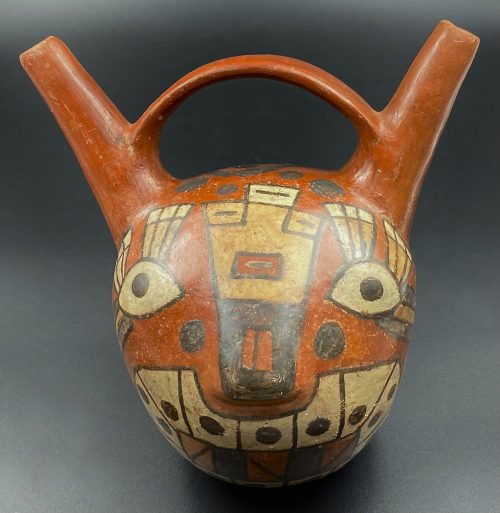 Pre-Columbian, Peru, Wari (Huari) culture, ca. 650 to 1000 CE.
Pre-Columbian, Peru, Wari (Huari) culture, ca. 650 to 1000 CE.A hand-built polychrome ceramic stirrup vessel depicting the head of a jaguar. Painted with a sienna-hued base, this spotted beast features an abstract visage of almond-shaped eyes opened wide with long feather-like lashes, a rectangular nose protruding from a nasal bridge decorated with a quadrilateral motif, and a large open mouth, showing both upper and lower teeth, which are also spotted, all painted in shades of cream, black, cream, grey, light grey, and beige. Highly burnished, the lustrous vessel exhibits two spouts, also functioning as ears of the jaguar, with a flat handle arching between them. This tool would have been a grave good intended to hold some kind of libation or offering and was likely made in a specialist workshop.
Colours: Sienna (base), black, cream, grey, light grey, beige (7 colours).
Dimension: Width (mouth-to-mouth): 15 cm; Height: 14.5 cm; Diameter of the body: 10.5 cm. Provenance: Hans Juergen Westermann collection, Germany. The Wari State was the first expansionistic power to develop in the Andean highlands. It was located in Vilcabamba, modern Espiritu Pampa (Plain of the Spirits), Echarate District of La Convención Province in the Cuzco Region of Peru. The Wari expanded around AD 650 and by the time of their collapse in AD 1000 they controlled much of the central Andes. -

Iron tsuba of round form decorated with a deer and maple leaves in positive silhouette openwork (ji-sukashi), with details finely carved in low relief (kebori). Nakagō-ana plugged with copper fittings (sekigane). Traces of lacquer on the surface.
NBTHK: Hozon, №424947.
Design: An autumnal tsuba with an allusion to Kasuga Shrine in Nara.
Attributed by NBTHK to Shoami. Age: Probably the Momoyama period (1574 – 1603) or early Edo period (1603 – 1650), but judging on the item's substantial size (diameter 86.6 mm) and considerable thinness (3.4 mm) may be attributed to earlier times (late Muromachi period, 1514 – 1573). -
 A shakudō kozuka decorated with equestrian tack inlaid in raven black shakudō, gold uttori and a silver alloy on a nanako ground. Unsigned. Attributed to Goto Joshin (Japanese, 1513 – 1562), 3rd generation Goto master. Late Muromachi period, Tenbun era (c. 1550). Size: 96.7 x 14.4 x 4.9 mm. Tokubetsu Hozon certificate № 2004230 issued by NBTHK on May 10, 2017. For a detailed explanation of terms see: Sesko, Markus. Handbook: Of Sword Fittings Related Terms. Germany: Books on Demand, 2011.
A shakudō kozuka decorated with equestrian tack inlaid in raven black shakudō, gold uttori and a silver alloy on a nanako ground. Unsigned. Attributed to Goto Joshin (Japanese, 1513 – 1562), 3rd generation Goto master. Late Muromachi period, Tenbun era (c. 1550). Size: 96.7 x 14.4 x 4.9 mm. Tokubetsu Hozon certificate № 2004230 issued by NBTHK on May 10, 2017. For a detailed explanation of terms see: Sesko, Markus. Handbook: Of Sword Fittings Related Terms. Germany: Books on Demand, 2011. -
 Iron tsuba of round form with design of military commander's fan (gunbai) in openwork (sukashi). Square rim. Hitsu-ana plugged with lead or tin. Ko-tosho school. Mid Muromachi period. Late 15th century: Entoku era [1489-92] / Meio era [1489-1501]. Height: 80.3 mm, Width: 81.5 mm, Rim thickness: 3.0 mm. Centre thickness: 3.5 mm. Provenance: Sasano Masayuki Collection, №23 in Japanese Sword Guard Masterpieces from the Sasano Collection, 1994: Ko-tosho. Sukashi design: Military commander's fan (gunbai). Mid Muromachi period. Late 15th century (Entoku / Meio era). The military commander's fan (gunbai) was cherished by samurai warriors. This tsuba is relatively thick, with the large fan nicely positioned on the plate.
Iron tsuba of round form with design of military commander's fan (gunbai) in openwork (sukashi). Square rim. Hitsu-ana plugged with lead or tin. Ko-tosho school. Mid Muromachi period. Late 15th century: Entoku era [1489-92] / Meio era [1489-1501]. Height: 80.3 mm, Width: 81.5 mm, Rim thickness: 3.0 mm. Centre thickness: 3.5 mm. Provenance: Sasano Masayuki Collection, №23 in Japanese Sword Guard Masterpieces from the Sasano Collection, 1994: Ko-tosho. Sukashi design: Military commander's fan (gunbai). Mid Muromachi period. Late 15th century (Entoku / Meio era). The military commander's fan (gunbai) was cherished by samurai warriors. This tsuba is relatively thick, with the large fan nicely positioned on the plate. -
 Iron tsuba decorated with sparrows and bamboo inlaid and chiseled in yellow brass, with snow lying on bamboo leaves inlaid in silver-ish shibuichi. Copper sekigane. The kogai-hitsu-ana probably cut out at a later date. Heianjō school. Unsigned. Height: 86.0 mm, Width: 85.4 mm, Thickness at seppa-dai: 2.9 mm. Momoyama or early Edo period, first half of the 17th century. Merrily Baird, Symbols..., page 118: "The association of the sparrow (suzume) with both bamboo and rice heads is an old one found in Japanese poetry, paining, and design."
Iron tsuba decorated with sparrows and bamboo inlaid and chiseled in yellow brass, with snow lying on bamboo leaves inlaid in silver-ish shibuichi. Copper sekigane. The kogai-hitsu-ana probably cut out at a later date. Heianjō school. Unsigned. Height: 86.0 mm, Width: 85.4 mm, Thickness at seppa-dai: 2.9 mm. Momoyama or early Edo period, first half of the 17th century. Merrily Baird, Symbols..., page 118: "The association of the sparrow (suzume) with both bamboo and rice heads is an old one found in Japanese poetry, paining, and design." -
 An iron tsuba of 12-lobed form with alternating four solid and four openwork areas, each with a central bar. Symbolism remains unclear, possibly - a gunbai, i.e. military leader's fan. The solid parts decorated with 5 to 6 rows of brass dots of nail heads inlaid in ten-zōgan. The center of the plate as well as the sukashi elements are outlined with brass wire. The kozuka-hitsu-ana seems original. Muromachi period. Dimensions: 77.9 x 77.5 x 3.2 mm.
An iron tsuba of 12-lobed form with alternating four solid and four openwork areas, each with a central bar. Symbolism remains unclear, possibly - a gunbai, i.e. military leader's fan. The solid parts decorated with 5 to 6 rows of brass dots of nail heads inlaid in ten-zōgan. The center of the plate as well as the sukashi elements are outlined with brass wire. The kozuka-hitsu-ana seems original. Muromachi period. Dimensions: 77.9 x 77.5 x 3.2 mm. -
 Iron tsuba of round form with slanting rays of light (shakoh) Christian motif (Jesuit's IHS symbol) in openwork (sukashi). Traditional description of this kind of design is called "tokei", or "clock gear". Edo period.
Iron tsuba of round form with slanting rays of light (shakoh) Christian motif (Jesuit's IHS symbol) in openwork (sukashi). Traditional description of this kind of design is called "tokei", or "clock gear". Edo period.Size: 83.4 x 83.1 x 4.4 mm
Signed Bushū-jū Ujishige saku (武州住氏重作) [Markus Sesko]. Ujishige (died 1677), 3rd generation of the Katsuki-Gondayu line; 1st gen. Ujiie came from Kyoto to Kaga to work for the Maeda family. There was another Ujishige, 4th generation Kaneko (?), who died in 1867 [M. Sesko, Genealogies...], but this tsuba looks a bit earlier than that. This particular Ujishige states in his signature that he is from Bushū, or Musashi Province, modern Tokyo Metropolis. He might have moved from Bushū to Kaga, of course. There is no artist with the name Ujishige in Bushū-Ito School anyway.
For information regarding shakoh tsuba see article 'Kirishitan Ikenie Tsuba by Fred Geyer at Kokusai Tosogu Kai; The 2nd International Convention & Exhibition, October 18-23, 2006, pp. 84-91. -
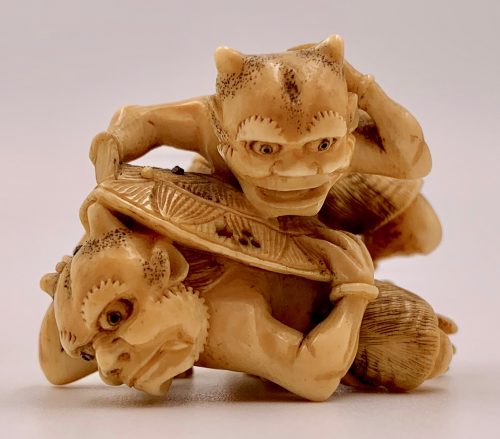
Ivory netsuke with the design of wrestling Oni by Kaigyokusai Masatsugu [懐玉齋正次].
Signed: Masatsugu [正次] Osaka School. Made: 1850-1900; Late Edo - Meiji Period. Dimensions: 44 x 40 x 33 mm.The right hand of the upper Oni and one toe of the lower Oni are missing. Ref.: Raymond Bushell. Collector's netsuke. Weatherhill, NY, Tokyo; Ninth printing, 2002, pp. 84-87. "Kaigyokusai Masatsugu (1813-1892) was an Osaka based carver renowned for his flawless technique as illustrated upon this netsuke with its finely carved ivory form, with no staining and bright inlaid eyes" (V&A).
-
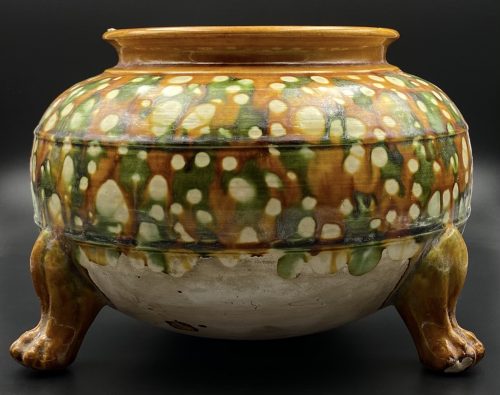 A tripod earthenware jar with the upper half decorated with three-colour glaze in brown, green, and white, and the bottom half unglazed; spur marks to the mouth. Henan kiln. China, the Tang dynasty [唐朝] (618 – 907). Diameter: 22 cm; Height: 15.5 cm
A tripod earthenware jar with the upper half decorated with three-colour glaze in brown, green, and white, and the bottom half unglazed; spur marks to the mouth. Henan kiln. China, the Tang dynasty [唐朝] (618 – 907). Diameter: 22 cm; Height: 15.5 cm -
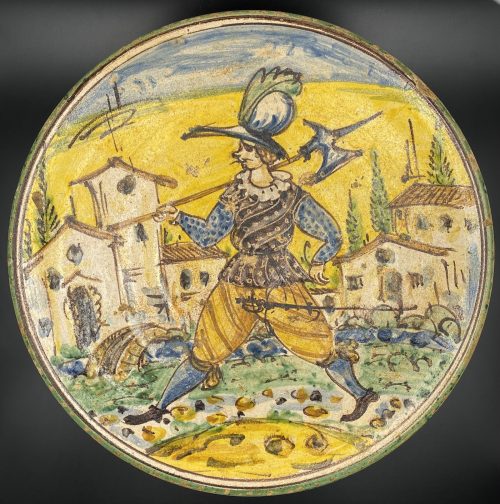 Footed round dish depicting a gentleman in an urban landscape holding a halberd in a style of "Arlecchino di Montelupo". Unsigned. Chips to the bottom. Diameter: 32.5 cm; Height: 4.5 cm. Produced in Italy, in Montelupo, about 20 kilometres (12 miles) southwest of Florence. 17th century, probably the first half. "After 1630, the year of the great plague, the number of potters reduced considerably and in the second half of the 1600s production suffered a drastic slump, potteries that specialized in a more prestigious production disappeared completely leaving only the potteries that produced kitchenware and terracotta objects" [www.tuscany-charming.it].
Footed round dish depicting a gentleman in an urban landscape holding a halberd in a style of "Arlecchino di Montelupo". Unsigned. Chips to the bottom. Diameter: 32.5 cm; Height: 4.5 cm. Produced in Italy, in Montelupo, about 20 kilometres (12 miles) southwest of Florence. 17th century, probably the first half. "After 1630, the year of the great plague, the number of potters reduced considerably and in the second half of the 1600s production suffered a drastic slump, potteries that specialized in a more prestigious production disappeared completely leaving only the potteries that produced kitchenware and terracotta objects" [www.tuscany-charming.it]. -
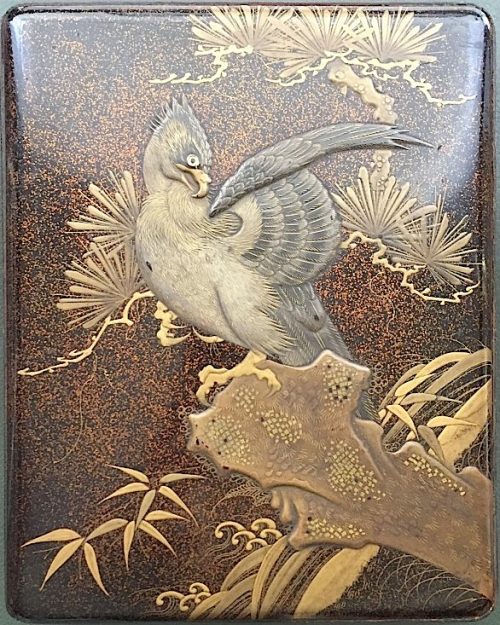 Japanese lacquer writing box (suzuribako) with an eagle sitting on a pine tree over the see waves. Rectangular box with rounded corners, slightly convex overlapping lid. Lacquer on wood with maki-e decoration in gold powder. The lid decorated inside with pine cones and needles over gold maki-e. Edo or Meiji period, 19th century.
Japanese lacquer writing box (suzuribako) with an eagle sitting on a pine tree over the see waves. Rectangular box with rounded corners, slightly convex overlapping lid. Lacquer on wood with maki-e decoration in gold powder. The lid decorated inside with pine cones and needles over gold maki-e. Edo or Meiji period, 19th century. -
 Iron tsuba of round form with design of wheel (kuruma) in openwork (sukashi). Squared rim. Copper sekigane. Yagyu school. Signed of the face: Fukui Tsuguzaemon. Early Edo period: Late 17th century (Kanbun/Enppo era). Height: 76.7 mm. Width: 76.8 mm. Rim thickness: 5.2 mm. Center thickness: 5.6 mm. Provenance: Sasano Masayuki Collection, № 203: "This design of spoke wheel relates to the 'circular principle' found in the Yagyu philosophy. Although it is very faint, Fukui Tsuguzaemon's signature is visible. Without a signature and based on appearance alone, it would undoubtable attributed to a later period".
Iron tsuba of round form with design of wheel (kuruma) in openwork (sukashi). Squared rim. Copper sekigane. Yagyu school. Signed of the face: Fukui Tsuguzaemon. Early Edo period: Late 17th century (Kanbun/Enppo era). Height: 76.7 mm. Width: 76.8 mm. Rim thickness: 5.2 mm. Center thickness: 5.6 mm. Provenance: Sasano Masayuki Collection, № 203: "This design of spoke wheel relates to the 'circular principle' found in the Yagyu philosophy. Although it is very faint, Fukui Tsuguzaemon's signature is visible. Without a signature and based on appearance alone, it would undoubtable attributed to a later period".Merrily Baird in her book "Symbols of Japan" [Merrily Baird. Symbols of Japan. Thematic motifs in art and design. Rizzoli international publications, Inc., 2001] provides the following explanation of the Wheel-of-the-Law symbol: "The Wheel-of-the-Law or Golden Wheel (rimbo, kinrin) has its origins in India, where it is known as chakra. [...] In Buddhist practice, it has been represented with eight spokes, reflecting the eight-fold path to overcoming worldly desire, and it signifies that all illusions will be crushed by the faith's enlightenment. [...] The Wheel-of-the-Law is an attribute of such deities as Senju Kannon, the Thousand-Armed Kannon, and Dainichi Nyorai, the all-illuminating solar figure who is the principal deity for Shingon Buddhism. From the Edo period on, the wheel also has been used in a secular manner", e.g. on family crests.
-
 Iron tsuba of 8-lobed form pierced with six openings (sukashi) and decorated with design of bamboo and arabesque in flat brass inlay (hira-zōgan). Two of the openings serve as hitsu-ana. The design on the face represents bamboo trunks and leaves, clouds, waves, and vines; on the back - vines and leaves, that forms an arabesque (karakusa) motif. Rounded square rim. 'Silver' patina. Hitsu-ana with copper sekigane. Heianjō (most probable) or Kaga-Yoshirō school. Late Muromachi or Momoyama period; 16th century. Size: Height: 74.6 mm; Width: 69.5 mm; Thickness at seppa-dai: 4.2 mm. Weight: 113.9 g. Provenance: Gary D. Murtha. This tsuba is illustrated at: Japanese sword guards. Onin - Heianjo - Yoshiro by Gary D. Murtha [GDM Publications, 2016, p. 48]: "Iron, 80x75x3 mm tsuba with brass karakusa vines and leaves on one side with bamboo, leaves, and clouds on the reverse. This tsuba is one of those pieces that might be classified as Onin or Heianjo work, but the flush inlay tips it to the Heianjo side. Late Muromachi period." I would like to add that it easily may also be classified as Kaga-Yoshirō. Robert Haynes in Study Collection.., page 32, illustrates a look-a-like example, and writes: "This style of inlay, where the designs on the face and the back are very different, was common to the work of artists in Kyoto in the Momoyama period."
Iron tsuba of 8-lobed form pierced with six openings (sukashi) and decorated with design of bamboo and arabesque in flat brass inlay (hira-zōgan). Two of the openings serve as hitsu-ana. The design on the face represents bamboo trunks and leaves, clouds, waves, and vines; on the back - vines and leaves, that forms an arabesque (karakusa) motif. Rounded square rim. 'Silver' patina. Hitsu-ana with copper sekigane. Heianjō (most probable) or Kaga-Yoshirō school. Late Muromachi or Momoyama period; 16th century. Size: Height: 74.6 mm; Width: 69.5 mm; Thickness at seppa-dai: 4.2 mm. Weight: 113.9 g. Provenance: Gary D. Murtha. This tsuba is illustrated at: Japanese sword guards. Onin - Heianjo - Yoshiro by Gary D. Murtha [GDM Publications, 2016, p. 48]: "Iron, 80x75x3 mm tsuba with brass karakusa vines and leaves on one side with bamboo, leaves, and clouds on the reverse. This tsuba is one of those pieces that might be classified as Onin or Heianjo work, but the flush inlay tips it to the Heianjo side. Late Muromachi period." I would like to add that it easily may also be classified as Kaga-Yoshirō. Robert Haynes in Study Collection.., page 32, illustrates a look-a-like example, and writes: "This style of inlay, where the designs on the face and the back are very different, was common to the work of artists in Kyoto in the Momoyama period." -
 An iron tsuba in the shape of a bold or shaved human head in full round. Unsigned. Dimensions: 62.5 x 53.4 x 4.4 mm Iron, in the shape of a Ni O (Nio) head, in full round, the back flat chased as a pine forest. Signed : Miōchin Masatsugu in sosho. №38 in The Naunton Collection, 1912. There are a few tsuba of such design known. SOLDIron, a severed head. Signed: Takeaki of Kwaiyō. Ex Hawkshaw Collection [Plate VII]. Below written: Takurio, Suruga, 1118; Tamagawa, p. ; Tanaka, p. 168; Tanetora, 1894. №2729 in The Naunton Collection, 1912.
An iron tsuba in the shape of a bold or shaved human head in full round. Unsigned. Dimensions: 62.5 x 53.4 x 4.4 mm Iron, in the shape of a Ni O (Nio) head, in full round, the back flat chased as a pine forest. Signed : Miōchin Masatsugu in sosho. №38 in The Naunton Collection, 1912. There are a few tsuba of such design known. SOLDIron, a severed head. Signed: Takeaki of Kwaiyō. Ex Hawkshaw Collection [Plate VII]. Below written: Takurio, Suruga, 1118; Tamagawa, p. ; Tanaka, p. 168; Tanetora, 1894. №2729 in The Naunton Collection, 1912.
№38 Naunton Collection, 1912.
Reference to Hawkshaw Collection [Plate VII] happened to be not exact; it is Plate VIII, №236. It is clearly not the Hawkshaw piece (different facial expression, signle hitsu-ana, no plug. Description at Hawkshaw, 1910, reads: Iron, in the shape of a man's head, severed at the neck, the forehead in three wrinkles, the mouth hard-set and drooping, the eyes open, inlaid brass with shakudo pupils. Signed: Shoami; dated second year of Shoho, first month [SV: December 1644 through February 1648].
№2729 Naunton Collection, 1912.

№236 Hawkshaw Collection, 1910.


